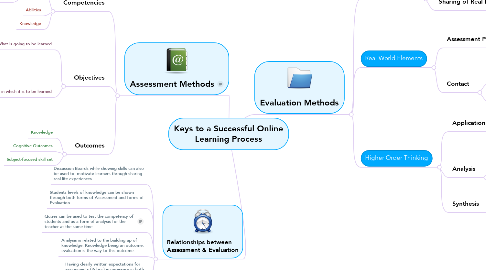
1. Relationships between Assessment & Evaluation
1.1. Discussion Boards while showing skills can also be used to motivate learners through sharing real life experiences.
1.2. Students levels of knowledge can be shown through both forms of Assessment and forms of Evaluation.
1.3. Quizes can be used to test the competency of students and as a form of analysis for the teacher at the same time.
1.4. Analysis is related to the building up of knowledge. Knowledge being an outcome, evaluation is the way to this outcome.
1.5. Having clearly written expectations for assignments (Rubric) is necessary in both Assessment and Evaluation
1.6. Clear Learning Objectives are vital in both Assessment and Evaluation as well.
2. Assessment Methods
2.1. Competencies
2.1.1. Skills
2.1.1.1. Discussion Boards
2.1.1.2. Tests
2.1.2. Abilities
2.1.3. Knowledge
2.2. Objectives
2.2.1. What is going to be learned
2.2.1.1. Learning Objectives
2.2.1.2. Syllabus
2.2.2. The process in which it is to be learned
2.2.2.1. Activities
2.2.2.2. Assessments
2.2.2.3. Group Work
2.2.2.3.1. Data Sharing and Compliling
2.2.2.3.2. Communication
2.2.2.3.3. Pulling together of resources
2.3. Outcomes
2.3.1. Knowledge
2.3.2. Cognitive Outcomes
2.3.3. Subject-focused skill set
3. Evaluation Methods
3.1. Motivate Learners
3.1.1. Incorporate Technology
3.1.1.1. encourage students to use new forms of technology, apps, or websites to construct their assignments.
3.1.2. Sharing of Real Life Experiences
3.1.2.1. Create an educational environment where students feel open to share their experiences
3.2. Real World Elements
3.2.1. Assessment Package
3.2.1.1. use links to examples of assignments the student constructs for the assessments
3.2.1.2. Write clear learning Objectives
3.2.1.3. Have a clearly written Rubric
3.2.2. Contact
3.2.2.1. Communication between student and instructor
3.2.2.2. Communication between student and other students
3.3. Higher Order Thinking
3.3.1. Application
3.3.1.1. Perform a Task
3.3.1.1.1. Create a Slideshow
3.3.1.1.2. Make a concept map
3.3.1.1.3. Create a video
3.3.2. Analysis
3.3.2.1. Quizes
3.3.2.1.1. shows knowledge of concepts
3.3.2.2. Discussion Boards
3.3.2.2.1. Shows a students attitude
3.3.2.2.2. Displays how they adapt socially when in a setting with others (Adjustments)
3.3.3. Synthesis
3.3.3.1. Composing a written document (like a paper)
3.3.3.1.1. Displays understanding of concepts

